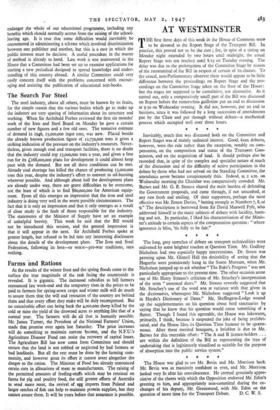The Search For Steel
The steel industry, above all others, must be known by its fruits, for the simple reason that the various bodies which go to make up the industry are very sparing of information about its structure and working. When Sir Archibald Forbes reviewed the first six months' work of the Iron and Steel Board on Monday he gave a certain number of new figures and a few old ones. The tentative estimate of demand in 1946, 15,000,000 ingot tons, was new. Placed beside the already known production figure of 12,75o,00o tons it gives a striking indication of the pressure on the industry's resources. Never- theless, given enough coal and transport facilities, there is no doubt that the industry could top 13,000,000 tons a year, and given a free run for its £168,000,000 plans for development it could almost keep pace with the demand. But not all these conditions can be met. Already coal shortage has killed the chance of producing 13,000,000 tons this year, despite the industry's effort to convert to oil-burning wherever possible. And although about half the development plans are already under way, there are grave difficulties to be overcome, not the least of which is to find $6o,000,000 for American equip- ment. From all this emerges an impression that the iron and steel industry is doing very well in the worst possible circumstances. The fact that it is only an impression and that it only emerges as a result of close study is the fault of those responsible for the industry. The statements of the Minister of Supply have set an example of unhelpful brevity. This week he said that the Bill would not be introduced this session, and the general impression is that it will appear in the next. Sir Archibald Forbes spoke at greater length, but refused to be led into any interesting disclosures about the details of the development plans. The Iron and Steel Federation, following its best—or worst—pre-war traditions, says nothing.


































 Previous page
Previous page